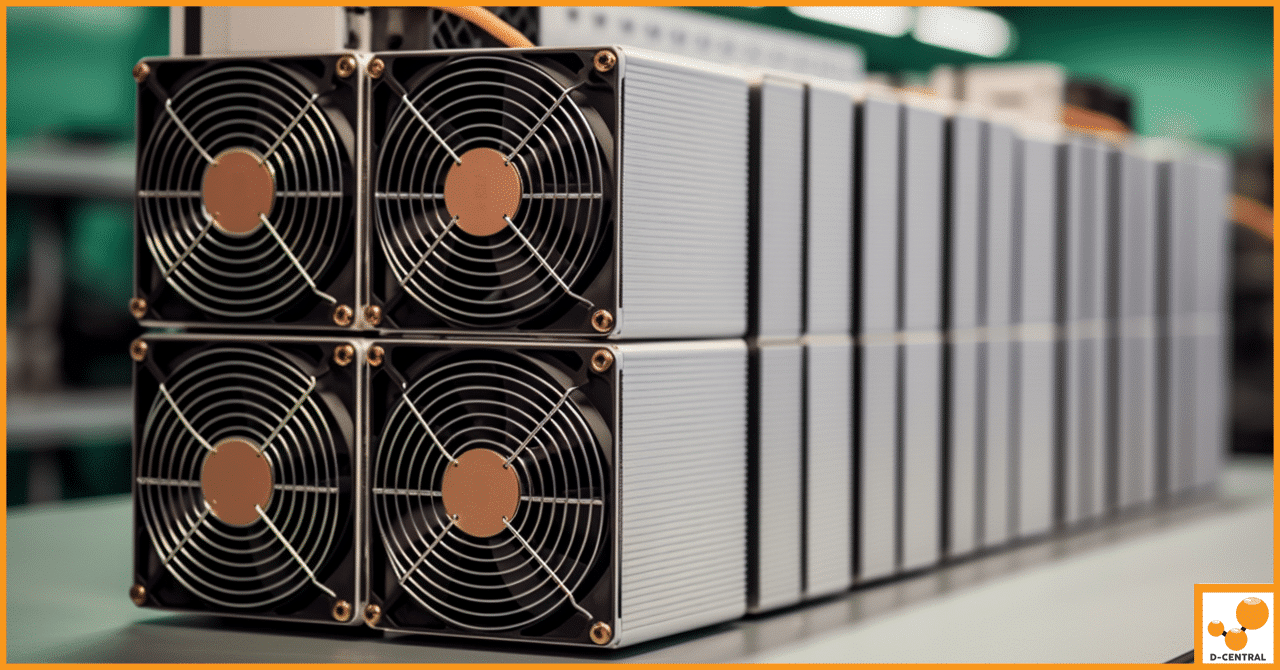
Understanding NerdMiner: Educational Tool and Entry-Level Mining Device
Bitcoin mining forms the backbone of the blockchain technology that underpins cryptocurrencies. It involves validating new transactions and recording them
4479 Desserte Nord Autoroute 440, Laval, QC H7P 6E2

Bitcoin mining holds a place of paramount importance. It is the engine that drives the Bitcoin network, a complex process that both secures the blockchain and introduces new Bitcoins into circulation.
Bitcoin mining is not just about earning Bitcoin. It’s a critical function that maintains the integrity of the Bitcoin network. Miners validate transactions, preventing double-spending and ensuring the trustworthiness of the network. Without miners, the Bitcoin network would be susceptible to attacks and fraud.
But Bitcoin mining is more than just a protective measure. It’s also the mechanism by which new Bitcoins are created. With every block mined, miners are rewarded with new Bitcoins, effectively introducing new coins into the ecosystem. This process is a key part of Bitcoin’s controlled supply, ensuring that only 21 million Bitcoins will ever exist.
As we delve deeper into the world of Bitcoin mining, we’ll explore its evolution, the role of specialized hardware, and the factors to consider when setting up a mining operation. We’ll also look at the future of Bitcoin mining and its role in the broader cryptocurrency ecosystem. Whether you’re a seasoned miner or a curious newcomer, this comprehensive guide will provide you with a detailed, technical, and complete perspective on Bitcoin mining.
Bitcoin mining has come a long way since its inception. In the early days, Bitcoin mining was a far cry from the industrial-scale operations we see today. Back then, anyone with a computer could mine Bitcoin. The process was simple, and the competition was relatively low.
In the beginning, Bitcoin mining was conducted on CPUs (Central Processing Units), the same processors that power most computers. This was the era of solo mining, where individual miners would work independently to find new blocks. The rewards were significant – 50 Bitcoins per block – and because there were fewer miners, the chances of earning those rewards were higher.
As Bitcoin gained popularity, the mining landscape began to change. Miners discovered that GPUs (Graphics Processing Units) were far more efficient at mining Bitcoin than CPUs. GPUs, which are designed to handle multiple calculations simultaneously for video rendering, proved to be excellent for the number-crunching required in Bitcoin mining.
The next leap in mining technology came with the introduction of FPGAs (Field Programmable Gate Arrays). These devices were more energy-efficient than GPUs, offering faster hash rates while using less electricity.
However, the real game-changer in the Bitcoin mining industry was the development of ASICs (Application-Specific Integrated Circuits). These are chips designed specifically for Bitcoin mining. They offer incredibly high hash rates while using significantly less power than their predecessors. Today, ASIC miners dominate the Bitcoin mining landscape.
As the competition increased and the reward for mining a block decreased due to Bitcoin’s halving events, individual mining became less profitable. This led to the rise of mining farms and pools.
Mining farms are large-scale operations where multiple mining machines operate simultaneously. These farms, often located in areas with cheap electricity, have turned Bitcoin mining into an industrial process.
On the other hand, mining pools are groups of miners who combine their computational resources to mine Bitcoin more efficiently. The rewards are then split among the pool members, providing a steady income stream.
The evolution of Bitcoin mining from a hobbyist activity to an industrial-scale operation mirrors the growth and maturation of the Bitcoin network itself. As we move forward, the world of Bitcoin mining continues to evolve, presenting new opportunities and challenges.
Bitcoin mining is a complex process that involves solving mathematical problems, validating transactions, and maintaining the security of the Bitcoin network. To fully understand Bitcoin mining, it’s essential to grasp the process, the role of miners, and the concepts of mining difficulty and halving.
Bitcoin mining involves solving complex mathematical problems using computational power. These problems are essentially puzzles that a miner’s computer needs to solve to add a new block of transactions to the blockchain. The first miner to solve the problem gets to add the new block and is rewarded with a certain amount of Bitcoin and transaction fees.
The mathematical problem that miners need to solve is finding a hash – a product of a cryptographic function – that is below a certain target value. This process is essentially a random guesswork, which is why it requires a significant amount of computational power.
Miners play a crucial role in the Bitcoin network. They validate and record transactions into the blockchain, ensuring the integrity and security of the network. By solving the mathematical problems, miners prevent double-spending and maintain the decentralization of the Bitcoin network.
Miners are also responsible for the creation of new Bitcoins. The Bitcoin protocol rewards miners for their work by giving them newly minted Bitcoins and transaction fees. This reward system incentivizes miners to continue mining, which in turn secures the network.
Mining difficulty is a measure of how hard it is to find a new block compared to the easiest it can ever be. The difficulty adjusts approximately every two weeks, or every 2016 blocks, to ensure that a new block is added to the blockchain every 10 minutes on average. If more miners join the network and the hash rate increases, the difficulty will go up. If miners leave the network and the hash rate decreases, the difficulty will go down.
Bitcoin halving is an event where the reward for mining new blocks is halved, meaning miners receive 50% fewer Bitcoins for verifying transactions. Bitcoin halvings occur approximately every four years, or every 210,000 blocks. The halving reduces the supply of new Bitcoins, making the remaining Bitcoins more valuable. The last halving event occurred in May 2020, reducing the block reward from 12.5 to 6.25 Bitcoins.
Understanding these concepts is crucial for anyone involved in Bitcoin mining. They influence the profitability of mining and the value of Bitcoin itself. As we delve deeper into the world of Bitcoin mining, these concepts will continue to play a significant role.
Bitcoin mining has evolved significantly since its inception, and so has the hardware used for mining. From CPUs to ASICs, each type of mining hardware has its unique advantages and challenges. Understanding these different types of hardware is crucial for anyone interested in Bitcoin mining.
CPU Miners: In the early days of Bitcoin, mining was done using Central Processing Units (CPUs). These are the processors that power most computers. However, as Bitcoin mining evolved, CPUs became obsolete due to their low speed and high energy consumption.
GPU Miners: Graphics Processing Units (GPUs) were the next step in the evolution of Bitcoin mining hardware. GPUs are much faster than CPUs and are capable of performing more calculations per second, making them more efficient for mining. However, they also consume a lot of electricity, which can be a significant cost factor.
FPGA Miners: Field Programmable Gate Arrays (FPGAs) are integrated circuits that can be programmed to perform specific tasks. In the case of Bitcoin mining, they offer a significant improvement in terms of both speed and energy efficiency over GPUs.
ASIC Miners: Application-Specific Integrated Circuits (ASICs) are the current gold standard in Bitcoin mining. These are custom-built for mining Bitcoin, offering unparalleled speed and energy efficiency. However, they are also the most expensive type of mining hardware and are not versatile (they can only be used to mine Bitcoin or other cryptocurrencies with the same hashing algorithm).
When comparing these types of mining hardware, ASICs are the clear winner in terms of raw performance and energy efficiency. They are specifically designed for mining, which allows them to outperform other types of hardware. However, ASICs are also the most expensive option and lack versatility.
GPUs, while not as powerful or efficient as ASICs, are more versatile. They can be used to mine a variety of cryptocurrencies and can also be used for other tasks such as gaming or 3D rendering.
CPUs and FPGAs are less commonly used for mining today. CPUs are relatively slow and inefficient, while FPGAs offer a balance between performance and flexibility but are more complex to use.
The introduction of ASIC miners has significantly changed the Bitcoin mining landscape. Their superior speed and efficiency have made them the preferred choice for serious miners. This has led to an arms race among miners, who are constantly seeking the latest and most powerful ASICs in order to stay competitive.
However, the rise of ASICs has also raised concerns about centralization. Because ASICs are expensive and require a significant investment, they are often out of reach for individual miners. This has led to a concentration of mining power in the hands of a few large mining farms, which could potentially threaten the decentralized nature of Bitcoin.
In the ever-evolving world of Bitcoin mining, staying informed about the latest hardware developments is crucial. Whether you’re a seasoned miner or a newcomer to the field, understanding the different types of mining hardware can help you make informed decisions and optimize your mining operations.
Choosing the right Bitcoin mining hardware is a critical decision that can significantly impact the profitability of your mining operation. Several factors come into play when selecting the best mining hardware, including the cost, hash rate, energy efficiency, and durability of the equipment.
The initial cost of the mining hardware is a significant factor to consider. High-performance mining hardware like ASICs can be quite expensive, and it’s essential to weigh this initial investment against the potential returns. It’s also important to consider the resale value of the hardware, as mining equipment can become obsolete quickly due to the rapid pace of technological advancements in the field.
The hash rate of a miner is the number of calculations it can perform per second. A higher hash rate increases the chances of finding the next block and receiving the mining reward. Therefore, when choosing mining hardware, it’s crucial to consider its hash rate. However, a higher hash rate often comes with increased energy consumption, which can impact profitability.
Bitcoin mining can be energy-intensive, and the cost of electricity can significantly impact the profitability of mining. Therefore, the energy efficiency of the mining hardware is a critical factor to consider. More energy-efficient hardware can mine Bitcoin using less electricity, reducing operational costs and increasing profitability.
Mining hardware is typically running continuously, which can lead to wear and tear over time. Therefore, the durability and longevity of the hardware are important considerations. High-quality hardware that is built to last can be a more cost-effective choice in the long run, even if it comes with a higher upfront cost.
Choosing the right Bitcoin mining hardware requires careful consideration of these factors. By understanding the importance of cost, hash rate, energy efficiency, and durability, you can make an informed decision that maximizes the profitability of your Bitcoin mining operation.
In the competitive world of Bitcoin mining, having the right hardware can make all the difference. The market is filled with a variety of mining machines, each with its unique strengths and weaknesses. Here, we’ll explore some of the most popular and efficient mining machines currently on the market and compare their performance, cost, and energy efficiency.
The Bitmain Antminer S19 Pro is considered one of the best options on the market for Bitcoin mining. While it’s more expensive than other machines, it delivers an impressive hash rate of 110 Th/s. The Antminer S19 Pro is known for its power efficiency, consuming 3250 W. The cost of this machine is approximately $3,230.
The Bitmain Antminer S19 XP Hyd is another high-performance mining machine. It boasts a remarkable hash rate of 255 Th/s, making it one of the most powerful miners on the market. However, this high performance comes with a higher price tag and energy consumption.
The Bitmain Antminer S19 XP is a slightly less powerful version of the S19 XP Hyd, offering a hash rate of 140 Th/s. It’s a more affordable option for those looking for a balance between cost and performance.
The Canaan Avalon Made A1366 is a reliable and efficient mining machine from one of the leading manufacturers in the industry. It offers a good balance between performance, cost, and energy efficiency.
The MicroBT Whatsminer M50S and M56S are popular choices among miners for their high hash rates and energy efficiency. These machines are known for their durability and longevity, making them a good investment for long-term mining operations.
When choosing a Bitcoin mining machine, it’s important to consider not only the cost and performance but also the energy efficiency and durability of the machine. These factors can significantly impact the profitability of your mining operation. As the Bitcoin mining industry continues to evolve, staying informed about the latest developments in mining hardware can help you make the most of your mining activities.
*List updated on 2023-07-31
Bitcoin mining pools are a significant aspect of the Bitcoin mining landscape. They offer a way for individual miners to work together and increase their chances of mining a block. Here, we’ll explore the concept of mining pools, their pros and cons, and provide an overview of some popular mining pools.
Mining pools are groups of miners who combine their computational resources to mine Bitcoin more efficiently. By pooling their resources, they increase their collective hash rate, which increases their chances of finding a new block. The rewards for mining a block are then split among the pool members, usually in proportion to the amount of computational power each miner contributed.
Joining a mining pool has several advantages. The most significant benefit is the more consistent income. Mining Bitcoin solo can be hit or miss; you could go a long time without mining a block and receiving a reward. By joining a pool, miners receive a share of the rewards more frequently, providing a more stable income.
However, there are also downsides to joining a mining pool. One is that the rewards have to be shared, so each miner receives a smaller portion of the total reward. Additionally, some mining pools charge fees, which can eat into your profits.
Based on recent data, some of the most popular and efficient mining pools include:
When choosing a mining pool, it’s important to consider factors such as the pool’s size, payout structure, fees, and reputation. By doing your research and choosing the right pool, you can maximize your Bitcoin mining profits.
Setting up a Bitcoin mining operation can be a rewarding but complex task. From choosing the right hardware to optimizing your setup for maximum efficiency, every step is crucial. Here, we provide a step-by-step guide on setting up a mining operation and offer tips for optimizing your mining setup.
Step 1: Choose Your Hardware
The first step in setting up a Bitcoin mining operation is choosing the right hardware. ASIC miners are the most efficient option for Bitcoin mining. Consider factors such as cost, hash rate, energy efficiency, and durability when choosing your mining hardware.
Step 2: Select a Mining Pool
While it’s possible to mine Bitcoin solo, joining a mining pool can provide more consistent rewards. Research different mining pools, considering their size, payout structure, fees, and reputation.
Step 3: Set Up Your Mining Hardware
Once you’ve chosen your hardware and mining pool, it’s time to set up your mining rig. This involves connecting your miner to a power source and your computer. You’ll also need to connect it to the internet.
Step 4: Install Mining Software
Next, you’ll need to install mining software on your computer. This software will control your mining hardware and connect you to the mining pool. There are several free mining software options available, each with its own advantages and features.
Step 5: Start Mining
Once your mining software is installed, you can start mining. Your mining software will take care of the rest, mining Bitcoin and depositing your earnings into your Bitcoin wallet.
Location: Choose a location with good ventilation and cooling to prevent your mining hardware from overheating.
Electricity Costs: Mining Bitcoin can be energy-intensive. Choose a location with low electricity costs to maximize your profits.
Maintenance: Regularly check and maintain your mining hardware to ensure it’s running optimally. This includes cleaning the hardware to prevent dust buildup and replacing any worn-out parts.
Security: Ensure your mining operation is secure. This includes both physical security for your mining hardware and cybersecurity for your Bitcoin wallet.
Setting up a Bitcoin mining operation can be a complex task, but with the right planning and preparation, it can be a profitable endeavor. By carefully choosing your hardware and mining pool, optimizing your setup, and regularly maintaining your equipment, you can maximize your Bitcoin mining profits.
While Bitcoin mining can be a profitable endeavor, it also comes with its share of risks and challenges. From security concerns to market volatility and environmental impact, miners must navigate a complex landscape. Here, we delve into these challenges and provide insights on how to mitigate them.
Security is a significant concern in Bitcoin mining. Miners must ensure the physical security of their mining hardware and the cybersecurity of their Bitcoin wallets. Cyber threats include hacking attempts, malware, and phishing attacks. To mitigate these risks, miners should use secure networks, regularly update their software, and use hardware wallets or other secure methods for storing their Bitcoin.
Bitcoin’s price is notoriously volatile. This volatility can significantly impact the profitability of Bitcoin mining. If the price of Bitcoin falls significantly, miners may find that the cost of mining (including electricity and hardware costs) exceeds the value of the mined Bitcoin. To mitigate this risk, miners can diversify their cryptocurrency holdings, participate in mining pools to reduce income volatility, and regularly monitor market conditions.
Bitcoin mining is energy-intensive and has been criticized for its environmental impact. The energy consumption of Bitcoin mining operations can contribute to carbon emissions, especially if the electricity used is generated from fossil fuels. To mitigate this impact, miners can choose to use renewable energy sources for their mining operations. Additionally, miners can invest in energy-efficient mining hardware, such as the latest ASIC miners, to reduce their energy consumption.
Navigating these risks and challenges is a crucial part of running a successful and sustainable Bitcoin mining operation. By understanding these issues and taking proactive steps to address them, miners can ensure their operations are secure, profitable, and environmentally friendly.
Bitcoin mining is a complex yet rewarding endeavor. It’s a critical component of the Bitcoin network, validating transactions, preventing double-spending, and introducing new Bitcoins into the ecosystem. From understanding the process of mining and the role of miners to choosing the right hardware and setting up a mining operation, every step is crucial in this journey.
We’ve navigated the evolution of Bitcoin mining, from humble beginnings with CPUs to the rise of powerful ASIC miners. We’ve explored the concept of mining pools and the benefits they offer to individual miners. We’ve also delved into the risks and challenges associated with Bitcoin mining, including security risks, market volatility, and environmental impact.
As you embark on your Bitcoin mining journey, remember that the right knowledge and tools can make all the difference. Equip yourself with the latest mining hardware, join a reputable mining pool, and stay informed about the latest developments in the Bitcoin mining landscape.
At D-Central, we’re committed to supporting miners at every step of their journey. We offer a range of services, including consultation, sourcing of mining hardware, hosting mining operations, ASIC repairs, maintenance training, and comprehensive mining support and outsourcing solutions. Whether you’re a seasoned miner or a newcomer to the field, we’re here to help you navigate the world of Bitcoin mining.
What is the purpose of Bitcoin mining?
Bitcoin mining serves two main purposes. It ensures the integrity of the Bitcoin network by validating transactions and preventing double-spending. It also is the mechanism for introducing new Bitcoins into circulation. With every block mined, miners are rewarded with new Bitcoins.
How has Bitcoin mining evolved over the years?
Bitcoin mining has evolved from a simple process performed by anyone with a computer to an industrial-scale operation. It started with mining performed on CPUs (Central Processing Units). With the increase in popularity of Bitcoin, miners discovered that GPUs (Graphics Processing Units) were more efficient than CPUs. This was followed by the introduction of FPGAs (Field Programmable Gate Arrays) and ASICs (Application-Specific Integrated Circuits), which are now the most dominant in the Bitcoin mining landscape.
What is a Bitcoin mining pool?
A Bitcoin mining pool is a group of miners who combine their computational resources to mine Bitcoin more efficiently. The rewards are then shared among the pool members, providing a steady income stream.
What factors should be considered when choosing Bitcoin mining hardware?
The initial cost, hash rate, energy efficiency, and durability of the Bitcoin mining hardware are the factors to consider when making a choice. ASIC miners are the most efficient option currently, but they are also the most expensive.
What are some of the popular Bitcoin mining machines on the market?
Some of the popular Bitcoin mining machines are Bitmain Antminer S19 Pro, Bitmain Antminer S19 XP Hyd, Bitmain Antminer S19 XP, Canaan Avalon Made A1366, and MicroBT Whatsminer M50S and M56S.
What are some risks and challenges associated with Bitcoin mining?
Security risks, market volatility, and environmental impact pose significant challenges to Bitcoin mining. It’s essential to ensure physical security and cybersecurity, keep tabs on market conditions and use renewable energy sources or invest in energy-efficient mining hardware to mitigate these risks.
How can D-Central support my Bitcoin mining journey?
D-Central offers a range of services to support miners including consultation, sourcing of mining hardware, hosting mining operations, ASIC repairs, maintenance training, and comprehensive mining support and outsourcing solutions.
DISCLAIMER: D-Central Technologies and its associated content, including this blog, do not serve as financial advisors or official investment advisors. The insights and opinions shared here or by any guests featured in our content are provided purely for informational and educational purposes. Such communications should not be interpreted as financial, investment, legal, tax, or any form of specific advice. We are committed to advancing the knowledge and understanding of Bitcoin and its potential impact on society. However, we urge our community to proceed with caution and informed judgment in all related endeavors.
Related Posts

Bitcoin mining forms the backbone of the blockchain technology that underpins cryptocurrencies. It involves validating new transactions and recording them

In this comprehensive exploration, we delve into the world of micro-mining and its potential to revolutionize Bitcoin’s mining landscape. Discover

As a cryptocurrency enthusiast and miner, I am always on the lookout for ways to improve my mining performance and